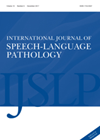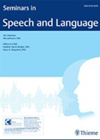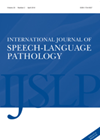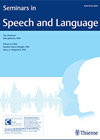
Journal Reviews
Sing it, say it, sort it: singing for Parkinson’s disease
Parkinson’s disease (PD) occurs in 1% of the population aged over 60. Changes in voice and speech are among the earliest and most prevalent symptoms of PD; reduced vocal intensity, monopitch, monoloudness, breathy and hoarse voice quality, imprecise articulation, vocal...
Does speech and language therapy provide value for money?
Within the NHS (and outside it), managers, commissioners and consumers will consider value for money as a key component in making a decision about whether to pay for speech and language therapy (or any other service for that matter). Yet...
Nothing about us without us: a how-to guide
Participatory design is an approach that is built around collaboration with users through a process of coproduction, design and creation. Most interventions are designed with the expert clinician researcher as the starting point, who looks at theory, evidence and their...
Do they talk the talk and walk the walk: self-rating measures versus reality
The aim of speech and language therapy interventions is to impact communication skills in everyday interactions. In order to measure this, rating scales (both self-rating and consultee-rating) are commonly employed in clinical practice settings. Many rating scales have been shown...
Take a breath between mouthfuls
Pulse oximetry provides a measure of the percentage of oxygen in the blood. The usual range of readings on pulse oximetry is 97-99%. Older people may have lower pulse oximetry readings than younger people, and young women have higher readings...
Doing it for yourself: self-management in speech and language therapy
People with stroke aphasia are traditionally discharged from speech and language therapy when they have plateaued; meaning they are making no further progress in language recovery. This service model has been problematic, leading to people being discharged when they are...
Training people with Parkinson’s disease and their partners to have better conversations
Parkinson’s disease is predominantly considered a motor disorder, impacting speech, particularly voice volume, amongst other physical functions. Language and cognitive difficulties, such as difficulties in word finding and social pragmatics are also a key feature of Parkinson’s disease. Given the...
Talking to the animals
People with communication difficulties have an increased risk of mood and anxiety disorders. This often means that speech and language therapists must actively engage in counselling as part of their intervention. It is not surprising, therefore, that the active components...
Don’t be too apologetic: disclosing communication difficulties
People who stutter are frequently considered less intelligent or less confident, and are often discriminated against. These negative perceptions have been found to differ slightly across different cultural groups. For Hebrew speakers in Israel, having a stutter can have a...
Swallowing and breathing: speech and language therapy
Swallowing difficulties are a common comorbidity in just over a quarter of people living with chronic obstructive pulmonary disease (COPD). Given the associated risks of aspiration and exacerbation of COPD symptoms, speech and language therapists (SLTs) can offer valuable guidance...
Is it really working? Assessment versus real-life language measures
Research in the field of language treatment and rehabilitation to date has used single-word naming as a controlled measure of outcome. Yet, given people do not actually communicate in single words, there is much debate as to whether this approach...
Let the maths do the talking for word-finding difficulties
Anomia (word-finding difficulties) can arise when a person has a stroke, dementia or other neurological disorder affecting the left (typically) hemisphere of the brain. There are lots of theories underlying the process of word retrieval, many of which have not...









